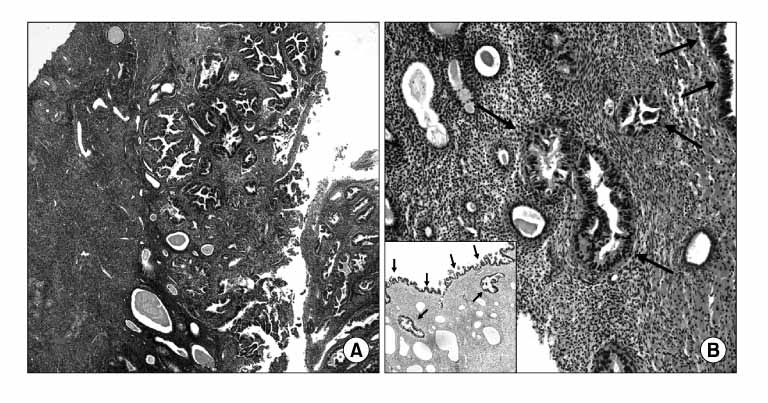J Gynecol Oncol.
2008 Dec;19(4):265-269. 10.3802/jgo.2008.19.4.265.
A case report of quadruple cancer in a single patient including the breast, rectum, ovary, and endometrium
- Affiliations
-
- 1Department of Obstetrics and Gynecology, Samsung Medical Center, Sungkyunkwan University School of Medicine, Seoul, Korea. bgkim@smc.samsung.com
- 2Department of Pathology, Samsung Medical Center, Sungkyunkwan University School of Medicine, Seoul, Korea.
- KMID: 2173418
- DOI: http://doi.org/10.3802/jgo.2008.19.4.265
Abstract
- Multiple primary cancer is defined as the multiple occurrence of malignant neoplasms in the same individual. Due to the development of new diagnostic techniques and the rise in long-term survival of cancer, reports of multiple primary cancers have gradually increased. Herein, we describe the case of a 68-year-old female patient with quadruple primary cancer of the breast, rectum, ovary, and endometrium. For its great rarity, we report this case with a review of the literature.
Keyword
Figure
Reference
-
1. Nakayama H, Masuda H, Ugajin W, Nakamura Y, Akiyama K, Suzuki K, et al. Quadruple cancer including bilateral breasts, Vater's papilla, and urinary bladder: Report of a case. Surg Today. 1999. 29:276–279.2. Ayhan A, Yalçn OT, Tuncer ZS, Gügan T, Küçüali T. Synchronous primary malignancies of the female genital tract. Eur J Obstet Gynecol Reprod Biol. 1992. 45:63–66.3. Moertel CG, Dockerty MB, Baggenstoss AH. Multiple primary malignant neoplasm: II. Tumors of different tissues or organs. Cancer. 1961. 14:231–237.4. Billroth T. General surgical pathology and therapeutics in 51 Vorlesungen: A textbook for students and physicians in fifty-one lectures. 1889. 14th ed. Berlin, DE: G. Rerimer.5. Warren S, Gates O. Multiple primary malignant tumors; Surgery of literature and statistical study. Am J Cancer. 1932. 16:1358–1414.6. Moertel CG. Multiple primary malignant neoplasms: Historical perspectives. Cancer. 1977. 40:Suppl 4. 1786–1792.7. Slaughter DP, Southwick HW, Smejkal W. Field cancerization in oral stratified squamous epithelium; Clinical implications of multicentric origin. Cancer. 1953. 6:963–968.8. Goodall J. The origin of epithelial new growths of the ovary. Surg Gynecol Obstet. 1911. 14:584.9. Lauchlan SC. Conceptual unity of the Mülerian tumor group: A histologic study. Cancer. 1968. 22:601–610.10. Iioka Y, Tsuchida A, Okubo K, Ogiso M, Ichimiya H, Saito K, et al. Metachronous triple cancers of the sigmoid colon, stomach, and esophagus: Report of a case. Surg Today. 2000. 30:368–371.11. Cunliffe WJ, Hasleton PS, Tweedle DE, Schofield PF. Incidence of synchronous and metachronous colorectal carcinoma. Br J Surg. 1984. 71:941–943.12. Kim CK, Chang JW. Multiple primary malignant tumors. J Korean Surg Soc. 1970. 12:63–71.13. Yun HK, Kim JB. Multiple primary malignant neoplasm. J Korean Surg Soc. 1984. 26:1–9.14. Koo DJ, Yun DS, Lee JJ, Park CJ. Clinical analysis of 65 multiple primary cancer cases. J Korean Surg Soc. 1999. 56:137–142.15. Moll UM, Chalas E, Auguste M, Meaney D, Chumas J. Uterine papillary serous carcinoma evolves via a p53-driven pathway. Hum Pathol. 1996. 27:1295–1300.16. Tashiro H, Isacson C, Levine R, Kurman RJ, Cho KR, Hedrick L. p53 gene mutations are common in uterine serous carcinoma and occur early in their pathogenesis. Am J Pathol. 1997. 150:177–185.17. Narod SA, Foulkes WD. BRCA1 and BRCA2: 1994 and beyond. Nat Rev Cancer. 2004. 4:665–676.18. National Comprehensive Cancer Network. NCCN clinical practice guidelines in oncology - Genetic/familial high-risk assessment: Breast and Ovarian. 2005. Fort Washington: National Comprehensive Cancer Network.
- Full Text Links
- Actions
-
Cited
- CITED
-
- Close
- Share
- Similar articles
-
- A case of metastatic adenocarcinoma of bladder from stomach cancer
- 8 Cases of Multiple Primary Gynecologic Cancer
- The effect of adjuvant hormonal therapy on the endometrium and ovary of breast cancer patients
- Hereditary portion as an initial genetic approach in gynecologic cancer: synchronous tumor of ovary and endometrium
- A case of carcinosarcoma of uterine endometrium associated with Tamoxifen use in breast cancer patient





